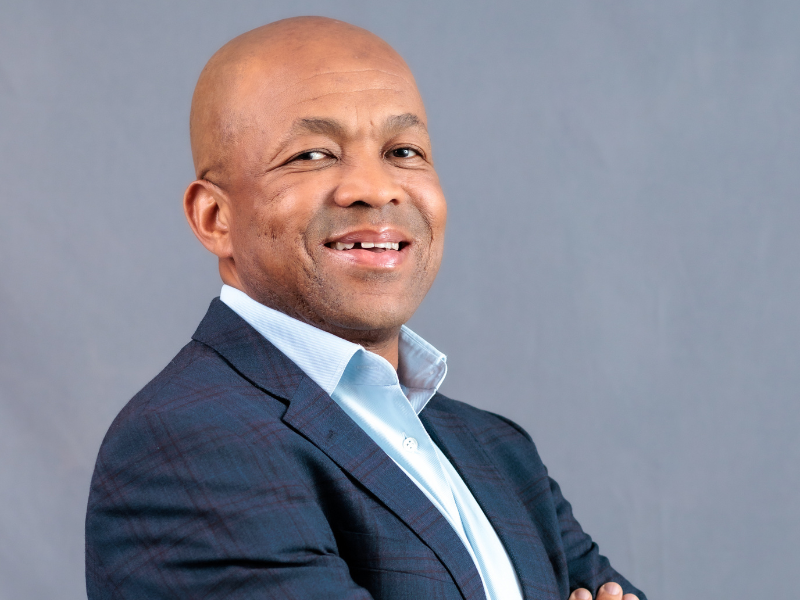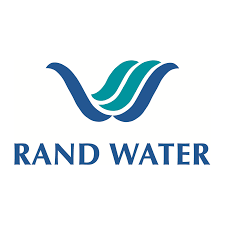
9 minute read
Cover Story - Sipho Mosai, Rand Water Group Chief Executive
122 Years and Counting - Congratulations Rand Water
Rand Water is a bulk water utility which currently serves over 18 million people across four provinces - Gauteng, parts of North West, Mpumalanga, and Free State - and spans an area of over 37 000km². It is the largest bulk water utility in Africa and one of the largest in the world.
Establishment of the Rand Water Board
After the peace agreement between the British Government and the Boer Republics on 31 May 1902 the British, who gained control of Johannesburg, realised that it was imperative to investigate the water supply and sanitation services. On 8 May 1903 the Rand Water Board was officially established by the Rand Water Board Incorporation Ordinance No. 32 of May 1903 to supply water to the entire area.
The Rand Water Board was to include members of the Johannesburg Town Council, The Chamber of Mines, and other existing local authorities in the Witwatersrand. In 1904 Rand Water was required to take over the undertakings of the companies at that time supplying or potentially capable of supplying water to the Witwatersrand. Rand Water was to supply water in bulk only.
Water Supply 1905
It was only in 1905 that Rand Water commenced full operations. By 1906 the annual daily consumption of water supplied by Rand Water was about 11 Mℓ/d and it has been growing ever since. In fact, Rand Water’s major challenge to date has been to augment its water sources to meet the growing demand.
Development Schemes
Fast forward to 1913… Water as a scarce resource in the Witwatersrand, as well as a need to supply a growing population, prompted the Water Board to impose some water restrictions as well as look for other sources of water. Major schemes were developed to respond to the demand.
The Following Were Some of The Major Development Schemes to Date:
The Vaal River scheme, which included the Barrage: 1914–1924– yielded 91 Mℓ/d
Vereeniging Pumping Station – 1924
Zwartkopjes Pumping Station
Vaal Dam – 1938 – 354 Mℓ/d
Zuikerbosch Pumping Station – 1949
Lesotho Highlands Water Project – 1998
Lesotho Highlands Water Project
Rand Water currently gets its water supply from the Lesotho Highlands. The scheme was designed to deliver a massive amount of some 2,2 x 109 m3 of water annually to South Africa. As early as 1954, the Natural Resources Development Council proposed the idea that water might be obtained from Lesotho to augment the water of the Vaal River. Negotiations between the governments of South Africa and Lesotho started towards the end of the 1970s.
Representatives of Lesotho, the European Union, the United Nations, and the World Bank formally signed a treaty for the development of the project on 24 October 1987 at an estimated cost of R5.5-billion. In 1997 this figure was increased to R9.1billion for the first phase of the project only. The scheme was to be constructed in three phases and would include four major dams, Senqu in Lesotho, Ash River in the Free State, Wilge River, and ultimately the Vaal Dam.
In the first phase, the Katse Dam and the Mohale Dam together with a series of tunnels were constructed in the Highlands of Lesotho. South Africa has to pay R150-million annually to Lesotho, whether the water is used or not, to augment the Vaal Dam water.

A Transformative Journey
Access to clean water is a fundamental constitutional right in South Africa - and we need robust, fully functional infrastructure to ensure its curation and delivery. Unfortunately, the ageing water system, built more than forty years ago, has suffered extensive wear and tear, leading to substantial water losses.
To address this critical issue, Rand Water is committed to providing a sustainable and dependable water supply –by providing cutting-edge water purification plants and expansive reservoirs to efficient pump stations and advanced automation. The company is on a transformative journey, making profound contributions to water management and service delivery, not just in South Africa, but across the African continent.
Rand Water Institute
Rand Water Institute (RWI) was established in 2020. Its establishment emanated from the realignment of Rand Water (its parent company) when it adopted a “risk-based innovation driven business strategy”. It has five pillars that collectively assist in achieving the vision and mission of the Institute, namely Research and Development, Innovation and New Technology Development, Partnerships & Collaboration, Sectoral Support and Coordination, Knowledge Transfer and Institute Support and Integration. The strategic focus of the Institute is on the business imperatives of Rand Water and the water sector, in line with Rand Water’s vision.
Rand Water, Group Chief Executive, Sipho Mosai
Heading up Rand water is Sipho Mosai, who assumed the role of Group Chief Executive of Rand Water in 2019. Before that he was Chief Operations Officer of Rand Water for 10 years.
Mosai, a scientist by training, turned strategist and business leader in the watersector, boasts over 20 years’ executive management and technical experience in bulk and distribution water operations; water infrastructure planning, maintenance, refurbishment and upgrade; project management, scientific services, strategic asset management; sector growth and development.
He has served as a non-executive and board member in various institutions. This includes serving on the board of the Construction Industry Development Board (CIDB) where he chaired the Human Resources subcommittee of the board in his first term and the Audit and Risk Committee in his second term.
He currently serves at the Rand Water Foundation and Rand Water Services as a non-executive director board member. Mosai holds the following qualifications:
Bachelor of Science (University of the North)
Bachelor of Science (Hons) (University of the North)
Master of Science (University of the Free State)
Post Graduate Diploma in Management (University of KwaZulu-Natal)
Master of Business Administration (University of KwaZulu-Natal)
Prescient Leadership
Under his leadership, Rand Water has achieved an international reputation for delivering water of the highest quality, consistently meeting and surpassing national and international standards.
“We are currently supplying 4554 Mℓ per day, to 17 municipalities, 27 mines, 2 railways, and 937 industries and direct customers – about 18 million people.” Over the last 4 years, Mosai has enhanced operational efficiency, all while nurturing strategic partnerships and spearheading sustainability initiatives.
“Rand Water is a bulk water supplier- it is not responsible for ensuring water flows to households but rather they are responsible for providing quality bulk water to the various municipalities whose job is to provide water services to the public. It is our duty to ensure that our bulk water meets high standards – we go above the standards set by the Department of Water and Sanitation and ensure that water that goes out to municipalities is both sufficient of quality and quantity,” - Mosai.
Rand Water operates by extracting water from the various water sources in South Africa such as the Vaal and then processes this raw water into clean drinking water. This is governed by an extraction license issued by the Department of Water and Sanitation that limits the amount of water it can extract.
On 3 November 2024 the Water and Sanitation Deputy Minister, David Mahlobo, joined Rand Water and the Emfuleni Local Municipality (ELM) to launch a Special Purpose Vehicle (SPV) aimed at enhancing the provision of water and sanitation services within the municipality.

“The SPV is a water utility that will be responsible for implementing, managing and carrying out the maintenance of water and sanitation service systems in order to ensure sustainable basic service delivery to residents, businesses, and industries and will help to address the growing water demand and efficient water services that align with national priorities for water security in the country,” – gov.za
2023 also saw the water utility launch two of its mega infrastructure projects, the 210 Mℓ Vlarkfontein Reservoir and the Zuikerbosch 5A station which will pump a massive 600Mℓ per day. Vlakfontein reservoir is the biggest post tension reservoir in Africa and amongst the biggest in the world and Station 5A is again the biggest purification plant that has been built in South Africa since the advent of democracy.
CSI
In collaboration with donors and stakeholders Rand Water coordinates, administers, and manages its Corporate Social Investment (CSI) resources, through the Rand Water Foundation, to support community development projects, making decisions that prioritise socio-economic benefits and supporting the broader objectives of the national government.
“Mosai’s commitment to social impact embodies the organisation’s core values of equity and caring, which are crucial in a nation where access to clean water is a fundamental matter of social justice,” – Prof JJ Tabane.
A Good News Story
Rand Water’s vision is to be a provider of sustainable, universally competitive water and sanitation solutions for Africa – and its mission is to consistently meet the expectations of customers, partners, and the government by strengthening capacity to:
Attract, develop and retain leading-edge skills in water services
Sustain a robust financial performance
Develop and sustain globally competitive capabilities in core areas
Enter into and sustain productive partnerships; and
Develop, test and deploy cost-effective technologies
Both the vision and mission are in steady hands under the prescient leadership of Sipho Mosai.
“Rand Water was created out of the ashes of the South African War to provide the foundation on which post-war reconstruction could be built. That institution predates the constitution that formed the foundation of the Union of South Africa in 1910. We should be proud of Rand Water, as it remains a testament to its founders over a century ago. Let us celebrate this good news story because it really is a very big deal,” – Anthony Turton, Daily Maverick.

Rand Waters’ 2024 Operational Achievements In Numbers
Unqualified audit report of 100%.
93% board member attendance.
0 days with unplanned bulk supply interruptions.
100% of the board resolutions were taken.
Customer satisfaction of 86%
Rand Water saw an actual water loss of 4.84% against its target of 5%.
100% of statutory reports were submitted on time.
B-BBEE spending as a % of total expenditure was 112%.
100% of work awarded to B-BBEE companies against a target of 85%.
46 corporate social initiatives.
3 municipalities were identified and given support.
100% project completion against the target of 95%
134% of the project expenditure was within the Rand value budget.
0 breaches.
Rand Water Finances
Rand Water’s gross profit margin through its primary activities was 31% against the estimated 29%.
Rand Water’s net profit margin through private activities was 23% against the 20% target.
Rand Water’s gross profit margin from secondary activities was 5.2% against the 5% target.
Rand Water’s net profit margin from secondary activities was 5% against the 1% target.
An 11.1% return on assets
Rand Water has a debtto-equality ratio of 0.08

Address: 552 Impala Road, Glenvista, 2058, South AfricaPhone Number: 0860 10 10 60Email: customerservice@randwater.co.zaWebsite: www.randwater.co.za
Source: Infrastructure News | Rand Water | Daily Maverick | Leadership | Gov.za










